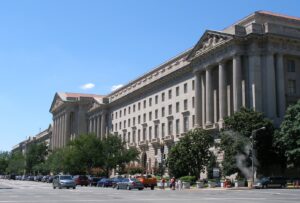
EPA Administrator Scott Pruitt may have resigned in shame, but the agency still needs to be fixed.
The following op-ed is by Jonathan Latham, Ph.D., co-founder and executive director of the Bioscience Resource Project, and was produced by Earth | Food | Life, a project of the Independent Media Insitute.
The Environmental Protection Agency has never been an institution whose primary allegiance was to the public interest. How do I know this? I have the agency’s own words for it. In late 2017 my organization, the Bioscience Resource Project, along with the Center for Media and Democracy, made available a vast trove of documents called the Poison Papers. These documents are two and a half tons of internal minutes, correspondence, reports, unsealed court documents, and more from the chemical industry and its regulators. Many of them originate from the EPA and date back to its inception in 1970.
The papers show many things, but one of them is that the agency has repeatedly overlooked strong evidence that independent chemical toxicity testing was fraudulent. EPA has known that laboratories skewed results in favor of applicants’ products. Sometimes, the agency has actively covered up such fraud.
EPA’s internal procedures for evaluating chemical safety were no better. Staff “cut and pasted” industry text into their reviews, failed to share evidence with external reviewers, and told applicants that products would be approved before applications had been fully evaluated. The agency also adopted reviewing procedures that make it highly unlikely that hazardous products would be identified as such. For example, data evidencing carcinogenic activity in test animals were repeatedly subjected to review and re-review until ways, as one employee wrote, “calculated to impress the uninitiated and the gullible” were found to disregard them. Meanwhile, evidence of non-carcinogenic toxicity was simply ignored. The situation was so bad in its Office of Pesticides that one EPA official accused his superior of having “downright contempt for the health of the American people.”
Having studied the documents as well as the agency itself, I would like to offer a diagnosis and propose some solutions. The inappropriate activities described in the documents are highly noteworthy on several counts. One is that they span a long time period; second, they occur across much of the agency; third, they are extremely diverse, spanning numerous procedural and scientific aspects; and fourth, they are spread across many complicit individuals. In other words, these derelictions do not demonstrate local branches gone rogue nor specific corrupted individuals, nor even specific situations. Rather, they reflect a deep conflict at the agency that is vastly more powerful than its written mandate to protect the public.
To understand why, it is necessary to get inside the head of the EPA. Imagine that zealous action on the part of EPA to protect human health from chemical toxicity or corporate malfeasance will engender strong feedback from the affected corporation, its lobbyists, and its other friends in Washington. The affected parties and its powerful friends will appeal to the president at whose “pleasure” the chief administrator of EPA serves. If that administrator does not have the president’s support for strong action, which he or she likely does not, then the best possible outcome for that agency—to avoid it suffering a damaging and embarrassing public humiliation—is for that evidence to never come to light. It should either be lost or buried, preferably as early in the evaluation process as possible.
This is the primary—unwritten—rule that has guided EPA from the beginning. The rule, known to every agency official, is that every finding of toxicity or corporate malfeasance is an institutional problem. The inevitable result is an institutional culture that regards findings of chemical toxicity as mistakes and aberrations.
The following represent some simple suggestions that, taking the above into account, would vastly improve the effectiveness of the Environmental Protection Agency.
First, divide EPA into two agencies. One half should be responsible for lawmaking and the other for enforcement. This removes what is at present a confusion of responsibilities in which the rule makers at EPA are incentivized to create loopholes so that no successful prosecutions will occur and result in conflicts such as described above.
Secondly, the leaders of each of these separate agencies should be responsible to Congress and not, as EPA’s chief administrator is now, to the president. The reason is that presently EPA can enforce environmental laws only if the president agrees. Under such circumstances the agency can never be a better environmental and health advocate than the person in the White House. With Donald Trump in charge of the White House the danger of this should be immediately clear.
The third proposal is to protect and reward whistleblowers. Whistleblowers are potential assets to society. They are individuals courageous enough and independent enough to bring the misdeeds of colleagues and other officials to public attention. Supposing they can prove that the performance of their colleagues is truly inappropriate or illegal, then whistleblowers should be positively rewarded, which at present they are not.
Public health and the environment need effective and independent advocates, for the sake of the climate, the oceans, and communities. These changes can make EPA into an agency that truly advocates for them, rather than one that merely pretends to act in their interest.
Jonathan R. Latham, PhD, is the co-founder and executive director of the Bioscience Resource Project, director of the Poison Papers Project, and editor of the Independent Science News website. He holds a master’s degree in crop genetics and a Ph.D. in virology.
